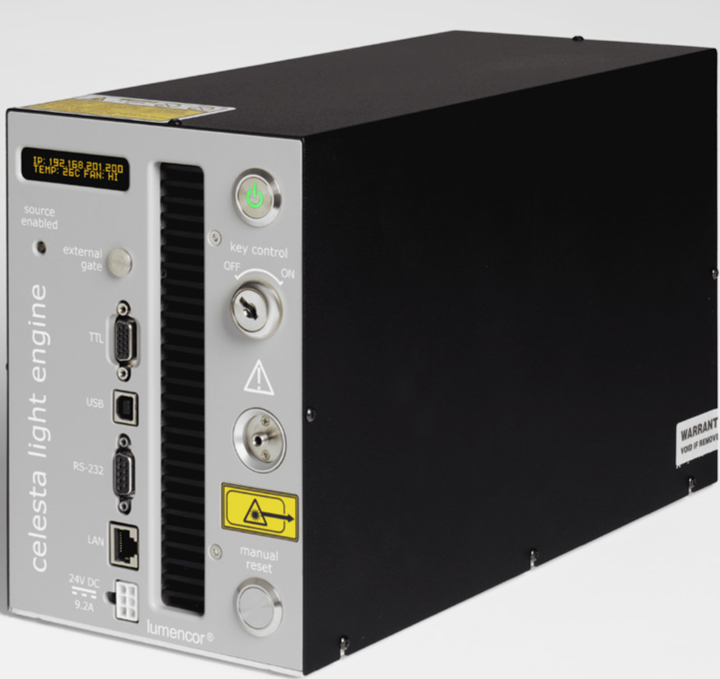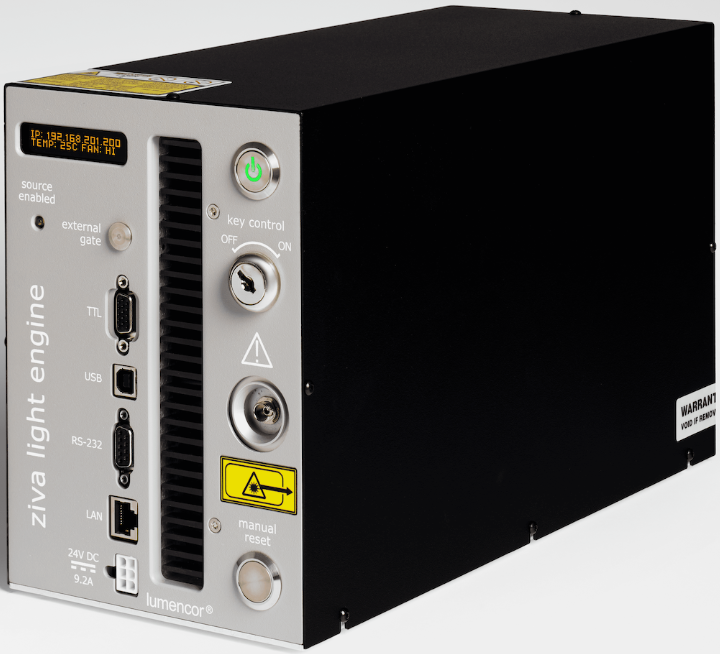Lumencor Laser Light Engines
BioVision Technologies offers the following Lumencor® Laser Light Engines® and related products:

CELESTA Light Engine
The Lumencor® CELESTA and CELESTA quattro Light Engines® incorporate arrays of 4–7 individually addressable solid-state lasers. CELESTA Light Engines marry the high brightness of LASERs with specialty beam shaping to deliver controlled, consistent, homogeneous illumination required for dedicated applications. CELESTA Light Engines are at home on CrestOptics spinning disk systems, spatially resolved transcriptomic platforms, and other advanced imaging applications demanding power, speed, and uniformity.
The CELESTA Light Engine brings together 7 independent, solid-state lasers with advanced electronic control to deliver unprecedented optical power and performance. The CELESTA quattro Light Engine provides the same levels of performance in an economical 4‐ or 5‐laser format.
The newest laser options are 488 nm, 577 nm, and 680 nm, bringing the total number to 10. Each laser output is refined by a bandpass filter and merged into a common optical train, passed through a despeckler, and directed to the light output port on the front of the Light Engine. The light output port has a built‐in adapter for facile connection to microscopes and other bioanalytical instruments through a SMA‐ or FC/PC‐terminated optical fiber. Laser output at the distal end of the optical fiber is ~800 mW from each laser.
CELESTA lasers are allied with sophisticated control and monitoring systems to deliver the performance needed for spinning disk confocal microscopy, spatial transcriptomics and other advanced imaging applications. When a microscopist requires high irradiance across a large field, the CELESTA Light Engine delivers reliable results. CELESTA Light Engines are often the illuminator of choice for CrestOptics V2 and V3 spinning disk confocal. This Lumencor Light Engine yields sufficient photon flux to fill that immense field of view (25 mm) on X‐Light V2 and V3. Moreover, the available power from each CELESTA laser supports the X-Light’s fast disk rotation. Microscopists whose large area, highly multiplexed samples demand fast acquisition choose CELESTA Light Engine as their preferred illumination tool.
The CELESTA’s controls reside on an onboard computer with an embedded command library. These commands give access not only to the basic functions of laser channel selection, on/off switching and output intensity adjustment, but also to an extensive set of operating status reports and adjustable preference settings. A GUI resident on the onboard computer provides convenient access to many of the command library functions using a Web browser via the Light Engine’s Ethernet connection. TTL trigger inputs are provided for all output lines for applications requiring fast (100 microseconds) switching. Real‐time performance tracking and stabilization feedback is included in the sophisticated, turn‐key design.
Lumencor’s complementary ZIVA and ZIVA quattro Light Engines are optimized for applications requiring laser light output coupling via narrow bore (≤200 µm diameter) optical fibers with low numerical apertures.
| Specifications | |
|---|---|
| Sources | 4, 5, or 7 individually addressable solid‐state laser light sources with discrete UV, visible and nIR outputs |
| Light Delivery | 1.5 mm diameter SMA‐terminated or 400 µm squareFC/PC‐terminated optical fiber |
| Safety Interlocks | Laser output contingent on manual (key) and remote (electronic) interlocks |
| Controller | Onboard microprocessor with server/client architecture and embedded command library |
| Control Interface—Ethernet | TCP or embedded GUI |
| Control Interface—USB or RS‐232 serial | Source on/off and output intensity |
| Control Interface—TTL | Independent on/off for each color channel |
| Speed | Maximum 5 kHz channel switching |
| Power Requirements | 100–240 V AC, 50–60 Hz. DC power supply (220 W, 24 V/9.2 A) and AC cord included |
| Dimensions | 145x340x203 mm (WxLxH) |
| Weight | 9 Kg |
| Warranty | 24 months |

ZIVA Light Engine
The Lumencor® ZIVA and ZIVA quattro Light Engines® incorporate arrays of 4–7 individually addressable solid-state lasers. Laser outputs are allied to sophisticated control and monitoring systems to deliver the performance needed for SIM, STORM, and other super‐resolution microscopy applications. The ZIVA Light Engine is now available for the Yokogawa Electric CSU.
The ZIVA Light Engine delivers ~100 milliwatts of output power from each of its seven laser light sources at the distal end of a 100 µm/0.1 NA optical fiber. Similarly, the ZIVA quattro Light Engine provides an economical 4‐ or 5‐line option with the same output power specifications. The laser outputs are allied to sophisticated control and monitoring systems to deliver the performance needed for structured illumination microscopy (SIM), stochastic optical reconstruction microscopy (STORM) and other super‐resolution microscopy applications. Lumencor’s complementary CELESTA and CELESTA quattro Light Engines® are optimized for applications requiring light output coupling via wider bore (≥ 400 µm diameter) optical fibers with larger numerical apertures. The ZIVA's control system resides on an onboard computer with an embedded command library. These commands give access not only to the basic control functions of output channel selection, on/off switching, and output intensity adjustment, but also to an extensive panel of operating status reports and preference settings. A GUI resident on the onboard computer provides convenient access to many of the command library functions using a Web browser via the Light Engine’s Ethernet connection. TTL trigger inputs are provided for all output lines for applications requiring fast (100 microseconds) switching. An onboard photodiode array continuously monitors the light output providing both real‐time performance tracking and feedback stabilization.
ZIVA Light Engine for Yokogawa Electric CSU
The Yokogawa CSU is a highly‐regarded spinning disk confocal scanner in widespread use for three‐dimensional imaging of live cells, tissues, and microorganisms. However, the range of fluorescence excitation wavelengths provided by lighting installed on CSU systems is often limited to four lasers. Further, the cost of these lasers often exceeds that of the CSU scanner itself. Lumencor’s ZIVA Light Engine increases the number of lasers from four to seven at a price significantly below that of the CSU scanner. The ZIVA’s lasers are refined by bandpass filters, merged into a common optical train, passed through a despeckler, and directed to the light output port on the front panel. Output wavelength is selected by direct on/off switching of the lasers. There is no potential for light leakage through an external selection device such as an AOTF. The Light Engine output is directed to the Yokogawa CSU scanner through a precision‐engineered adapter. This optical coupler provides intense and uniform illumination at the sample plane. All these capabilities are assembled in a compact, bench-top device with a 15x35 cm footprint.
| Specifications—ZIVA | |
|---|---|
| Sources—ZIVA | 7 Class 4 lasers |
| Sources—ZIVA quattro | 4 or 5 Class 4 lasers |
| Output Power | ~100 mW per laser at the distal end of a 100 μm‐diameter optical fiber |
| Light Delivery | Despeckler and FC/PC‐terminated fiber |
| Safety Interlocks | Laser output contingent on manual (key) and remote (electronic) interlocks |
| Controller | Onboard microprocessor with server/client architecture and embedded command library |
| Control Interface—Ethernet | Source selection, light output on/off and intensity control |
| Control Interface—USB or RS‐232 serial | Source selection, light output on/off and intensity control |
| Control Interface—TTL | Source selection and light output on/off |
| Speed | Maximum 5 kHz channel switching |
| Power Requirements | 220 W, (24 V DC/9.2A) power supply included |
| Dimensions | 145x340x203 mm (WxLxH) |
| Weight | 8.7 Kg |
| Warranty | 24 months |
| Specifications—ZIVA for Yokogawa Electric CSU | |
|---|---|
| Sources | 7 Class 4 lasers |
| Output Power | 250 mW (Violet) and 450 mW per laser at adapter output |
| Light Delivery | Output adapter for direct coupling to Yokogawa CSU scanner included |
| Safety Interlocks | Laser output contingent on manual (key) and remote (electronic) interlocks |
| Control Interface—Ethernet | Source selection, light output on/off and intensity control |
| Control Interface—USB or RS‐232 serial | Source selection, light output on/off and intensity control |
| Control Interface—TTL | Source selection and light output on/off |
| Onboard Metrology | Real‐time power, laser cumulative on‐time, internal temperature, humidity, dew point |
| Power Requirements | 100–240 V AC, 50–60 Hz. DC power supply (220 W, 24 V/9.2 A) and AC cord included |
| Dimensions | 145x340x203 mm (WxLxH) |
| Weight | 8.7 Kg |
| Warranty | 24 months |
